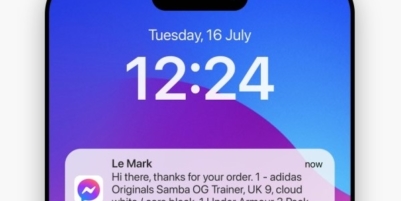-
BLACKOUT TECHNOLOGIES TARGETS TELEMATICS-INTEGRATED MOBILE DEVICE BLOCKING TO COMBAT SMARTPHONE DISTRACTION - April 1, 2025
-
OpenADR Alliance announces first OpenADR 3.0 certified products with EVoke Systems, E.ON Energy and Universal Devices - March 25, 2025
-
Growing fulfilment and contract packer appoints new Managing Director - March 25, 2025
-
When is it time to invest in a WMS? Understanding the key trigger points - March 25, 2025
-
eCapital helps Vantage Recruitment on its journey to financial success - March 24, 2025
-
Hugo Beck Celebrates 70 Years of Packaging Innovation with Open House Events - March 20, 2025
-
PROLOG FULFILMENT SUPPORTS LUNA DAILY’S COMMITMENT TO BETTER BODY CARE FOR ALL WOMEN - March 19, 2025
-
Motion Ventures launches largest-ever maritime tech fund at $100M to meet the industry’s new pace of adoption - March 18, 2025
-
ITD GLOBAL APPOINTS GROUP CHIEF REVENUE OFFICER - March 17, 2025
-
SURECAM TEAMS UP WITH ENTERPRISE FLEX-E-RENT FOR VEHICLE REPAIR & MAINTENANCE CONFERENCE - March 14, 2025
By Paul Dodd, CTO and co-founder of Huboo
Following two years of rocket-fuelled growth, there are signs that the eCommerce landscape is becoming more challenging to navigate, even for the biggest providers in town.
Amazon may still be hiring, but it’s also raising its prices as eCommerce sales slow. In recent weeks leading fashion retailers Zara and BooHoo have announced that they are starting to charge for online returns, a move that few would have predicted 12 months earlier.
eCommerce is still a vibrant and booming market, and McKinsey predicts that online marketplaces alone will account for almost a third of retail revenue in the next five years. But it’s clear that operational efficiency needs to be top of the eCommerce agenda if sales growth is to continue amidst a mounting cost-of-living crisis.
Equally clear, as more retailers attempt a multichannel approach to capitalise on growth – i.e. accessing more sales channels, across more markets – the limitations of traditional fulfilment strategies are becoming increasingly exposed, leaving providers unable to capitalise on the opportunities that are still out there.
In fact, this is a critical factor in understanding why eCommerce margins remain worryingly low – even for global brands like Amazon – and why almost 80% of new eCommerce businesses fail in their first year.
So how can retailers improve their sales without exposing themselves to a logistical nightmare. Here are five steps to help providers create a multi-market sales strategy that works in practice as well as on paper.
- Moving from multi to omnichannel
This is the crucial first stone laid on the pathway to fulfilment enlightenment. Traditionally retailers have relied on a multichannel fulfilment approach, but as sales channels diversify, companies are increasingly turning to omnichannel as a more efficient and flexible solution. While both approaches see retailers selling across a variety of platforms, the pivotal difference is that in multichannel sales, stock is rigidly assigned to one channel and can’t be sold to customers from another.
In contrast, with an omnichannel approach, inventory is fully integrated across sales channels, with a range of benefits for both the retailer and the customers they serve.
2. Keeping track of your inventory
Running and managing multichannel sales can be both complex and time-consuming. Companies often find that adding a new sales channel directly correlates to a surge of time-consuming admin – from securing additional warehouse space to accessing reliable local couriers. And then there’s the biggest challenge of all – keeping track of stock once multichannel operations are live and in progress.
An omnichannel approach helps to simplify business operations by syncing data from across sales channels and providing a real-time overview of both stock levels and customer orders. This means that online retailers are able to balance inventory with orders, regardless of the sales channel used by the customer.
What’s more, by streamlining multiple channels into a single process and giving retailers visibility of sales and stock from a centralised platform, an omnichannel approach results in a far higher degree of accuracy in both sales and delivery. All data is plugged into just one platform, meaning that the likelihood of having the correct stock to fulfil an order is greatly increased. This also helps to greatly reduce, if not eliminate, the chances of the wrong product being sent out – a mistake which could not only cost a sale, but also regular future custom.
3. Putting flexibility at the heart of your sales strategies
Companies relying on multichannel fulfilment can easily find themselves with distinct pockets of stock, each one accessible only to a particular sales channel. This can be problematic if they have an underperforming or overperforming sales channel and are unable to adapt their sales strategy in response.
Imagine, for example, that you are selling a product which is doing poorly on Amazon but flying off the shelves via Instagram. Without an omnichannel approach you could be forced to rely on Amazon to shift your remaining stock. With omnichannel, you have the flexibility to decide to shift your sales strategy to focus on Instagram, helping to speed up sales and positively impact your bottom line.
4. Future-proofing your business
For businesses still relying on traditional fulfilment, building a clear, holistic picture of how their operation is performing, and understanding what needs to change to make efficiencies and increase sales usually means spending hours wading through siloed data and spreadsheets.
An omnichannel approach helps eliminate this admin-intensive process by integrating data from across sales channels and giving retailers access to holistic business information on everything from product and channel trends to local courier performance – all from one platform. This can help retailers ensure their company is being run cost-effectively, while also giving them data-rich insights that empower them to adapt their business based on evolving customer needs.
5. Improving brand recognition
Smart businesses recognise that packaging is much more than simply a vehicle to get their product safely from A to B. Rather, it is a powerful tool for improving brand recognition and increasing the likelihood of returning customers.
Let’s take the case of an online retailer selling through Amazon. Not only is Amazon’s fulfilment network purpose-built to disincentive non-Amazon sales, but selling through the world’s biggest online marketplace also means having items delivered in the company’s trademark packaging. Conversely, with omnichannel fulfilment, the customer stays within the retail brand from sale to delivery. This increases brand recognition, meaning that customers are more likely to come back when they next need a product, rather than deferring to whatever is recommended by the Amazon algorithm.
6. Fulfilment – a critical component of any sales strategy
The retail industry needs to recognise that sales and shipping are two sides of the same coin. Without an integrated fulfilment approach, eCommerce businesses are unable to fully capitalise on potential sales. Even if they manage to grow via a multichannel approach, they’ll quickly find themselves struggling to stay on top of siloed sales channels.
By integrating stock, streamlining fulfilment and giving companies access to holistic sales data, an omnichannel approach enables retailers to streamline their operations while also giving them the space and flexibility to design more effective sales strategies. With retailers likely to look to further expand their number of sales channels to help manage the financial pressures caused by the cost of living crisis, there has never been a better time to make this shift in fulfilment strategy.

































